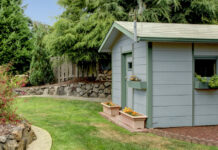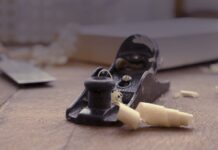Not so long ago you’d only see log cabins in cowboy movies, or perhaps while on holiday in the USA or Canada. But in recent years the log cabin has been growing in popularity over here.
Sometimes they’re built as holiday homes. They’re a popular way to enjoy glamping. They’re also popping up in people’s gardens from Lands End to John O’Groats, fulfilling the need for extra living space in the form of home offices, play spaces, smart garden storage, cosy private dens for teens and miniature house party venues.
There are increasing numbers of log cabins with hot tubs. Log cabin weekend breaks are hugely popular with families and couples alike. And residential log cabins make super permanent homes. You can buy log cabin kits and build your own holiday haven, a kids’ playroom in the garden or an outdoor home office. You can even build a log cabin simply as an alternative to a garden shed, much better looking and longer lasting than your ordinary, everyday shed.
Log cabins are eco-friendly, supremely cosy, natural, beautiful to look at and, when they’re built right and maintained properly, they can last for decades if not hundreds of years. We thought it’d be interesting to take a look at the rise and rise of the not-so-humble log cabin and explore the ins and outs of log cabin maintenance.
If you’re considering building one or getting someone else to build one for you, read on…
Britain’s love affair with log cabins
No wonder log cabin holidays are so popular. Picture this: you’ve booked a log cabin holiday with someone like Forest Holidays, just one of many providers. Their brand new Golden Oak Hideaway cabins are exclusively for couples, the ultimate romantic hideaway, and they come beautifully equipped with a hot tub, a wood burning stove, outdoor hammock, decking, a massive two-person sunken bath and panoramic forest views.
Then there’s Lincolnshire Lodges, which runs the gorgeous Highfields Retreat. It’s a haven for older people who want to make the most of retirement and people of working age who want an unusual second home. They have a bunch of top quality, affordable wooden lodges for sale in a lovely natural setting – 190 acres of private meadows, lakes and woodlands.
And what about Hoseasons, a household name holiday firm that’s grabbed the log cabin trend with both hands and run with it, offering a huge range of log cabin holidays and breaks in luxurious lodges.
No wonder more and more of us are building log cabins at home. Wood is wonderfully warm and cosy, solid and rugged, and you really can’t beat the tangy, fresh smell of timber. They tend to cost less to build than a regular bricks and mortar structure. And they look a whole lot nicer.
About log cabin kits
While building a log cabin from scratch might be a bit too much of a challenge for ordinary bods, most of us can handle a DIY log cabin kit with its simple instructions and all the materials you need delivered together. If not, plenty of kit retailers offer a home delivery and build service, where experts turn up and erect your cabin for you in no time. If you’ve ever struggled helplessly and failed to assemble a piece of flat pack Ikea furniture, ending up furious and frustrated, it’s probably your best bet!
Here are some UK firms offering wooden lodge kits, some of which also provide support putting them together:
- Log cabins UK – DIY or installed
- Little Cabin Company – importers of high quality sheds, wooden pods, cabins and log homes
- Mountain Lodge Homes – supplies beautiful traditional log home kits that last for generations
- Simply Log Cabins – high quality and attractive garden building kits
- Dunsterhouse – the UK’s biggest UK supplier
Looking after log cabins – Good log cabin maintenance
So you’ve bought and built your own log cabin, either using a kit, starting from scratch or getting an expert to build it for you. It looks absolutely fabulous. But how do you keep it looking that way for posterity?
Log home maintenance is mainly a matter of up-keeping the shell, the outside of the structure, to protect the wood from UV radiation, water damage, air infiltration and insects. The first thing to do is carry out an annual wash to get rid of dust, pollen, bird poo and insects debris like webs and egg sacs, all of which can prematurely wear off the finish. Washing the outside also lets you spot any knackered caulking, the stuff that goes in between the logs in some – but not all – cabin designs.
Wash the outside, let the wood dry then you’ll be in a position to make sensible decisions about what you need to do next. It’s important to know which type of wood stain, treatment or preservative has been used, if any. If it’s an oil-based log cabin preservative or treatment you’ll be able to see when washing whether the water is beading and running off the timber or soaking in. If water is soaking into the timber, it’s a sign that the oil treatment or preservative has worn off and needs replacing. One or two maintenance coats should do the trick.
If your log cabin features caulking, remove any failed caulking with a knife, let the surface dry out completely then add new caulking before re-staining.
Many experts recommend you fix rain gutters to your log cabin. They might not look brilliant, often far from rustic, but they can save you a fortune in the long run by helping prevent water damage.
Don’t forget the doors, door frames, windows and window frames. If they’re wood too, they’ll need an equal amount of care and attention to keep them looking and performing their best.
6 handy log cabin maintenance facts
- The single most important factor is cleanliness, cleaning and drying the surface and getting rid of pollen, dust and mould every season, especially the bits that face into the prevailing weather.
- The more moisture there is, the more potential there is for mould and mildew to grow. If your cabin is under trees, shaded or has a dripping roof line, mould and mildew will arrive sooner or later. But it’s a matter of regular maintenance. Using a mould and mildew cleaner to clean and clear any biological growth will help preserve the life of your log cabin for perhaps a lifetime.
- In Britain – so far – insects aren’t as much of an issue as they are in the USA, where log cabins are decimated by termites and carpenter bees. Climate change is bringing new risks as the weather warms, so fingers crossed we don’t end up with termites over here. If you do find woodworm or other insect damage, treat it appropriately then fill any small holes with wood filler before re-sealing the surface.
- A wood stain’s main job is to repel water and protect the surface from damaging UV rays, both of which can quickly degrade the surface. The pigment in wood stain helps keep the logs in prime condition.
- Do you need a water-based or oil-based stain? It depends on the cabin’s location and the weather in the area. Oil stain is often a thicker product which holds more pigment than its water-based counterparts. If your cabin already has an oil based stain, you must use another oil-based product for maintenance unless you completely remove the oil-based stain first. As a general rule you can’t mix and match oil and water-based products.
- Logs crack. It’s perfectly natural and nothing to worry about unless they’re in a place where exposure to the elements causes them to widen and broaden. The best way to prevent cracking is to clean the wood well and ensure that the wood is well preserved and oiled to keep it supple and protected from moisture and rain. If the split or crack is widening and becoming a problem, it can be either filled with an exterior wood filler or sealer or alternatively, sealed with a crafted splint of timber that fits the crack.
Recommended wood log cabin treatment
A good quality wood preservative is the best way to achieve longevity, and 2-3 coats of oil should do the trick. Some people use a coloured preservative with a clear oil on top, others use a clear preservative with a coloured oil on top for good looks as well as preservation.
We highly recommend the excellent Barrettine Log Cabin Treatment, a specially formulated clear oil that repels water like nobody’s business. We also have a great range of brilliant wood preservation products suitable for log cabins, wooden sheds and other wood buildings. Here’s a link to our dedicated log cabin treatment page.
Any questions?
As usual, our wood preservation experts are at hand to help and advise. Just call us for an informal chat with someone who knows their onions.





Most good quality log cabin kits are delivered with pressure treated bearers. These are usually around 45mm x 70mm or 70mm x 70mm. The purpose of these is to sit flat onto a pre-prepared base, ideally a concrete pad or some other similar base that has been prepared in such a way so as to avoid any settling out of any part of the base over the passage of time. This is a very important aspect of building log cabin kits and equally important as the timber treatment itself in terms of supporting the long term durability of a log cabin.
Many manufacturers offer a factory applied timber treatment on what otherwise would be the untreated parts of a log cabin. The advantage of this type of treatment is that every part of every piece will have a timber treatment applied to it and therefore all the little areas that you would not be able to access, and therefore would not get treated, during the process of applying a timber treatment in the garden, will have a timber treatment applied.
The disadvantages are; it can be difficult to source the commercial timber treatments that the factories use when it comes to the time that you need to re-apply timer treatment. This time always comes about quicker than expected simply owing to the natural qualities of expansion and contraction inherent with timber. Most reputable factories would refer to their treatments as a pre-treatment meaning that a treatment should be applied usually within a year but often much less than that. Secondly, factory applied timber treatments, being moisture based, will cause the wood to expand slightly. The better quality a log cabin is in terms of the corner joints being sawn to very fine tolerances to ensure weather protection, then the more that expansion can cause problems when it comes to assembling the kit. The corner joints are already tight but that expansion can make them very tight and can make the assembly quite awkward.
There is no clear cut answer as to whether factory applied timber treatment is a good thing or not. Personally, I think that it is usually quite expensive and on the whole, but not in every case, in my garden, I would build a cabin that I had treated myself.
For any information on Log Cabins, Garage or other garden buildings and timber treatments – please contact us through either: simplylogcabins.co.uk or
gardenchic.co.uk